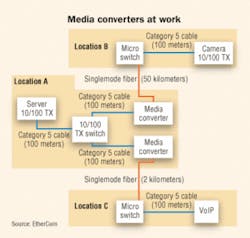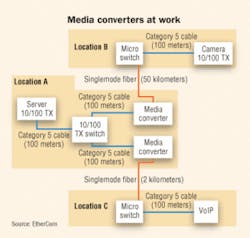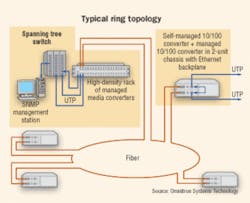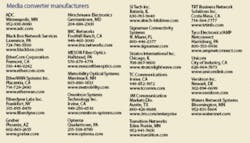Today’s intelligent converters do more than convert copper to fiber and back.
Media converters are making the leap from simple conversion devices to intelligent parts of the network.
In most cases, a media converter is used to convert copper to optical-fiber cabling, and vice versa. But they can also be used to switch from multimode to singlemode fiber, thus extending the fiber network considerably. Media converters make sense when an end user needs to mix and match media, as in copper and fiber, or different types of fiber. They continue to offer a cost-effective means for deploying fiber without requiring a forklift upgrade of switches and routers, and they have enabled IT managers to merge mixed cable types seamlessly and cost-effectively into existing network fabrics.
Today’s media converters, when compared to the cost of installing lengths of optical-fiber cable, are an inexpensive solution.
“By using media converters, your capital equipment costs can come down drastically,” says Nafis Ahmad, president of EtherCom Corp. (www.ethercom.com). “With low-cost media converters, copper to fiber can save a terrific amount on capital expenditure.”
The most common media converters are still copper-to-fiber devices. Companies like Metrobility Optical Systems (www.metrobility.com) report that 70 to 80 percent of the media converters it sells are copper-to-fiber.
Getting smarter with age
Media converters were originally used simply as a media extension tool, but the technology has evolved considerably over the past decade. “They are not the same as the original media converter,” says Alex Saunders, president of Metrobility Optical Systems.
Media converter management, something of a novelty a few years ago, is now becoming more prominent. Users employing media converter management can remotely monitor, configure, and get notification when changes are taking place or conditions-for example, environmental changes, such as temperature, or connectivity-are being met.
The push for new technology came as broadband and Ethernet users increasingly moved to mixed optical fiber and copper cable networking infrastructures, and network managers were presented with a bit of an unwelcome surprise: a management “black hole” at each fiber/copper media interface. The only way to confirm whether each media converter was operational was to visit individual wiring closets, which may, because of fiber’s potentially long lengths, be physically located many miles apart.
The potential for downtime caused some network builders to view media converters as the weakest link in a managed network infrastructure. As customers started deploying media conversion devices to increasingly critical points in the network, it became clear that more intelligence had to be built into the converter chassis, and that real management-not just primitive device monitoring-would be needed.
Thus, media converters, which were once considered “dumb” devices, are now intelligent and offer many more features. The devices can, for example, remotely retrieve statistics on their interfaces. Software can be downloaded so that they are capable of providing Ethernet loopbacks for carriers. They also provide link loss forwarding. Not surprisingly, the market for these remotely managed media converters has shown strong growth.
Media converters are constantly being reinvented into different flavors and applications. In today’s enterprise network, there may be thousands of media converters installed, linking switches, hubs, servers and even desktops to network resources.
“Initially, with this market, people laughed at it,” says Ahmad. “Now it is a very serious part of the network connectivity side. Media converters are getting quite sophisticated.”
Media converters are used as both temporary and permanent solutions. End users have media converters installed when they want to preserve their legacy infrastructure. The units bridge from legacy equipment to modern equipment without expensive network upgrades, and connect older equipment to a newer infrastructure.
What can you do for me today?
End users still look to media converters for distance extension, as opposed to just copper-to-fiber conversion. Devices from Metrobility, for example, support up to 100 kilometers, an extended horizontal distance. Such distance capabilities let end users take a decentralized approach to their operations, something that has grown in popularity following the 9/11 terrorist attacks. Many enterprise end users do not want to settle their operations in a monolithic office, not simply to avoid terrorist attacks but to avoid having a potentially single point of failure in the network.
A decentralized approach, with smaller offices networked together, often makes sense. It means spreading out singlemode fiber throughout the wide area network (WAN), and media converters provide an avenue to change multimode fiber over to singlemode and back.
Media converters are also being used to extend fiber networks to a factory environment where there are emission or noise problems. Signamax Connectivity Systems (www.signamax.com), for example, is preparing to introduce a hardened line of industrial media converters that have extended temperature and humidity ranges, as well as a hardened case. These devices are mountable on an industrial floor, or can be used in traffic control cabinets.
But today’s media converters are used for many more functions in the network than in a typical LAN environment. Advanced features, such as VLANs (virtual LANs), management and speed, are what many of today’s end users are seeking. Media converters were once used mainly in the horizontal space, between the telecom room and desktop. Now, they are moving into the metro network and customer network.
Today’s converters are being categorized as Ethernet access devices. Metrobility Optical Systems now offers a media converter that can handle voice, video and data traffic. And there is a growing migration toward small-form pluggable media converters, which let you provide a different SFP for different types of fiber so the module is constant.
“It’s a very serious business,” says Ahmad. “It’s no longer just stand-alone usage. Where someone once converted one media to another, now people are ordering media converters in racks.”
The latest media converters also offer fault detection and, on the fiber side, link detection. Many have built-in redundancy; if one link fails, the converters allow a switch to another link. They also offer auto-negotiation and forced mode availability for speed on the twisted pair side, and a mix of multimode for varying distances on the fiber side. For copper conversion, manufacturers report that converters that are capable of 10/100/1000 Base-T are selling briskly. For fiber conversion, switch media converters to Gigabit Ethernet are hot sellers.
Keeping up with Gigabit Ethernet
Newer media converters also offer a means to upgrade speed in a cost-effective manner. Devices that moved at 5 Mbits/sec are, for the most part, no longer being shipped. Today, most manufacturers say Gigabit Ethernet is the fastest growing type for overall shipments because many enterprise end users are using media converters to bring legacy equipment online with a gigabit backbone. About 25 percent of the media converters sold by Metrobility and Transition Networks are for gigabit transmission.
“It’s rolling out rapidly,” says Todd Duberstein, product manager for Transition Networks (www.transition.com). “Mostly every backbone in the networks is gigabit speed.”
Notes Saunders, “The typical company today has got all the workstations, interconnect, servers, switches-everyone is doing voice mail, Excel spreadsheets, PowerPoint. Network traffic can be peaking, and we find that people are upgrading their infrastructure to faster speeds.”
Omnitron Systems Technology (www.omnitron-systems.com) reports that 20 to 30 percent of media converters sold have gigabit speed. CEO Arie Goldberg says gigabit media converters allow separation of data streams between users’ groups and different servers to be provided on VLANs. They also allow for prioritizing of time-critical operations, such as Internet surfing or e-mail.
“The demand for this hit the market during the last couple of years, and we’ve seen a ramp up,” observes Goldberg.
Ron Thompson, director of systems development for Signamax Connectivity Systems, also sees more of its customers (about 40 percent) seeking media converters that are capable of gigabit speed. “They need gigabit because they are building a backbone network for high-speed interconnect across a multitude of switches,” says Thompson.
ADC (www.adc.com) reports that about 80 percent of its enterprise end user customers are now seeking media converters that are capable of gigabit speed. “Gigabit is rapidly becoming a de facto standard,” agrees Brian Van Voorhis, director of product management for wireline at ADC.
As long as there is copper�
Will media converters always be necessary? The current line of thinking is that as long as a majority of the existing buildings continue to have copper infrastructure, there will be a need for media conversion. For example, the majority of buildings constructed before 2000 have lower-cost copper voice and data wiring, which will need to be interfaced to new optical Ethernet services.
“I don’t think people will go into high-rise buildings and arbitrarily change the copper wiring there and put in fiber,” says Saunders.
Still, he says within the next 10 years, two things are expected to happen: End users will seek higher data rate speeds (gigabit speed is limited on copper, even with Category 5 and 6 cabling), and “As people convert to gigabit or 10-Gigabit, they will have to be on fiber, so those buildings will be rewired for those lengths.”
Goldberg agrees that it will be a long time before media converters are no longer necessary. End users, he says, aren’t going to go to an all-fiber network overnight. “There is a tremendous amount of copper infrastructure out there,” Goldberg says, “so at some point, you need to do a conversion between copper and fiber.”
Brian Milligan is senior editor for Cabling Installation & Maintenance.



